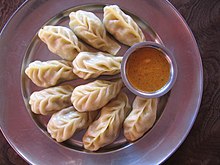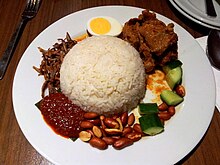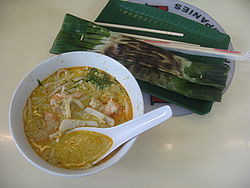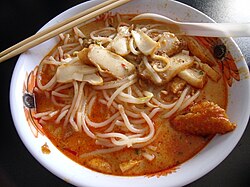因为它根本就不是个你要的答案。
Wednesday, May 30, 2012
Thursday, May 17, 2012
Naan
Naan is a leavened, oven-baked flatbread.[1] It is typical of and popular in West, Central and South Asia.[2][3][4]
Influenced by the large influx of South Asian immigrants, naan has also
become popular in other parts of the world, especially in Arab states of the Persian Gulf, Europe and North America.[5]
Originally, naan was a generic term for various flatbreads from different parts of the world.[6] In Turkic languages, such as Uzbek, Kazakh and Uyghur, the flatbreads are known as nan. The name stems from (New) Persian, being a generic word for bread. In Burmese, flatbreads are known as nan bya
dosa
Basic preparation
A mixture of Rice and Urad dal that has been soaked in water is ground finely to form a batter. The proportion of rice to lentils is basically 2:1 or 3:1. The batter is allowed to sit overnight and ferment. Sometimes a little Fenugreek seeds are added to the Rice-dal mixture. Rice can be uncooked or parboiled. The mixture of urad dal (black lentils) and rice can be replaced with highly refined wheat flour to make a maida dosa, or semolina for a rava dosa.A thin layer of the batter is then ladled onto a hot tava (griddle) greased with oil or ghee (clarified butter). It is spread out evenly with the base of a ladle or bowl to form a pancake. It is flipped to heat both crusts and removed from the griddle when the crust becomes dry. A dosa is served hot, either folded in half or rolled like a wrap.
Chapati
Chapatis are made from a firm dough made from flour (whole grain common wheat), 'Atta' in Urdu/Hindi/Punjabi/Bengali, and water. Some people also add salt and/or oil to the dough. Small portions of the dough are rolled out into discs much like a Mexican tortilla, using a rolling pin.
The rolled-out dough is thrown on the preheated dry skillet and cooked
on both sides. In some regions it is only partly cooked on the skillet,
and then put directly on a high flame, which makes it blow up like a
balloon. The hot air cooks the chapati rapidly from the inside. In some
parts of northern India (e.g. Punjab) and Pakistan, this is called a phulka (that which has been inflated).
Often, the top of a chapati is slathered with butter or ghee (clarified butter). A piece of chapati is torn off and used to pick up the meat or vegetable dish(es)that make the meal. It is folded into a sort of loose cone and used as a scoop to eat the more liquid dishes at a meal like pappu, paneer, or sena-galu.
Chapati sizes (diameter and thickness) vary from region to region and kitchen to kitchen. In Gujarat, for example, the chapati is called a 'rotli' and can be as thin as tissue paper. Chapatis made in domestic kitchens are usually not larger than 6-7 inches in diameter since the 'tava' from which they are made comes in sizes that fit comfortably on a domestic stove top. Tavas were traditionally made of unglazed earthenware, but are now typically made from metal. There are also electric tavas manufactured in India. The shape of the rolling pin also varies from region to region. Some households simply use a kitchen work top as a sort of pastry board, but homes have round flat-topped 'boards' specifically for rolling out chapatis that may be made of wood or stone.
Flat unleavened breads in South Asia come in many forms; the chapati is only one of them. A rotta, made of a dough similar to that used to make chapatis and cooked in an oven, is a 'tandoori roti'. The combination of wheat flour with one or more flours (e.g. chickpea, maize, or millet) will produce a "missi roti". Rottas made with pearl millet (bajra) or maize (makka) or jowar flour usually carry the name of the flour, as in "bajra roti" or "makke ki roti" (or "bhakri" in marathi). Flat breads like chapati and roti are traditionally a food of northern South Asia. The peninsular south, the east and northeast and the Kashmir valley are primarily rice-eating cultures. In southern India, there is a distinction made between a 'chapati' and its layered fried version the 'paratha'. 'Parathas' usually have a filling inside, such as spinach, cooked radish, or potato. Also now the 'tandoori roti' is to be found in the smallest towns.
Often, the top of a chapati is slathered with butter or ghee (clarified butter). A piece of chapati is torn off and used to pick up the meat or vegetable dish(es)that make the meal. It is folded into a sort of loose cone and used as a scoop to eat the more liquid dishes at a meal like pappu, paneer, or sena-galu.
Chapati sizes (diameter and thickness) vary from region to region and kitchen to kitchen. In Gujarat, for example, the chapati is called a 'rotli' and can be as thin as tissue paper. Chapatis made in domestic kitchens are usually not larger than 6-7 inches in diameter since the 'tava' from which they are made comes in sizes that fit comfortably on a domestic stove top. Tavas were traditionally made of unglazed earthenware, but are now typically made from metal. There are also electric tavas manufactured in India. The shape of the rolling pin also varies from region to region. Some households simply use a kitchen work top as a sort of pastry board, but homes have round flat-topped 'boards' specifically for rolling out chapatis that may be made of wood or stone.
Flat unleavened breads in South Asia come in many forms; the chapati is only one of them. A rotta, made of a dough similar to that used to make chapatis and cooked in an oven, is a 'tandoori roti'. The combination of wheat flour with one or more flours (e.g. chickpea, maize, or millet) will produce a "missi roti". Rottas made with pearl millet (bajra) or maize (makka) or jowar flour usually carry the name of the flour, as in "bajra roti" or "makke ki roti" (or "bhakri" in marathi). Flat breads like chapati and roti are traditionally a food of northern South Asia. The peninsular south, the east and northeast and the Kashmir valley are primarily rice-eating cultures. In southern India, there is a distinction made between a 'chapati' and its layered fried version the 'paratha'. 'Parathas' usually have a filling inside, such as spinach, cooked radish, or potato. Also now the 'tandoori roti' is to be found in the smallest towns.
Young tau fu
Yong tau foo ( also spelled yong tao foo, yong tau fu, or yong tau hu yong tofu) is a Chinese soup dish with Hakka origins commonly found in China, Singapore, Thailand and Malaysia. There are also Teochew and Hokkien variations.
It is ubiquitous in Singapore food courts, too. Essentially the dish
originated in the early 1960s in a restaurant called "Chew Kuan" as tofu
stuffed with a meat paste of fish and pork, thereby earning the dish
its name "Yong Tau Foo," which means "stuffed bean curd." Since then all
variety of vegetables and even fried fritters have been similarly
stuffed, and the name Yong Tau Foo has thus been used liberally to apply
to foods prepared in this manner.
Yong tau foo is essentially a clear consomme soup containing a varied selection of food items including fish balls, crab sticks, bittergourds, cuttlefish, lettuce, ladies fingers, as well as chilis, and various forms of fresh produce, seafood and meats common in Chinese cuisine. Some of these items, such as bittergourd and chili, are usually filled with fish paste
(surimi). The foods are then sliced into bite-size pieces, cooked
briefly in boiling broth and then served either in the broth as soup or
with the broth in a separate bowl. The dish is eaten with chopsticks and a soup spoon and can be eaten by itself (served with a bowl of steamed rice) or with any choice of egg or rice noodles, or bee hoon (rice vermicelli). Another variation of this dish is to serve it with laksa gravy or curry sauce. Essential accompaniments are spicy, vinegary chili sauce, similar to Indonesian sambal oelek, and a distinctive brown sweet bean sauce or hoisin sauce for dipping.In Malaysia and Singapore, the Malay Muslims have taken to yong tau foo in a big way. As pork consumption is prohibited for Muslims, halal yong tau foo is generally soy based or stuffed vegetable fritters or steamed bean curd with fish paste stuffing. To prepare the dish, these, a steamed rice-flour roll (similar to that used for chee cheong fun) and a vegetable called kangkong are boiled to heat and soften them. The food items are drained and eaten with sprinkled toasted sesame seeds, chili sauce and a hoisin based sauce. Another version commonly found in Perak state is the soup type where the food items are served in a broth and provided with chili sauce and hoisin based sauce dipping. Halal yong tau foo is normally sold by Malay vendors at night markets (pasar malam) and at halal food courts by non-Muslim vendors.
| Yong Tau Foo | |
|---|---|
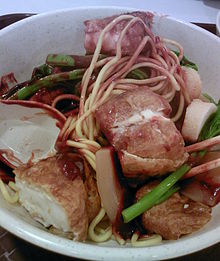 |
|
| Chinese | 釀豆腐 |
| Literal meaning | "stuffed bean curd" |
Nyonya food
China
has always traded with lands near and
far across
the globe. During the Ming Dynasty, as
a diplomatic gesture to strengthen
ties with the rich and strategic port
of
Malacca on the Malayan Peninsula,
the Emperor of China betrothed his
daughter
Princess Hang Li Po to the
Sultan of Malacca.
The royal princess and her entourage of about 500
formed the first permanent Chinese settlement in
Malacca at Bukit China or China
Hill. These early Chinese settlers wed local Malay brides and gave rise to the first generation
of mixed Chinese-Malays known as Peranakan, the male being known as Baba and the
female as Nyonya, pronounced nyoh-nyah and sometimes spelt Nonya.
The term 'Peranakan' originated in Indonesia for the descendants
of immigrant Chinese who had married and integrated with local Indonesians. Akin
to the Peranakan in
Indonesia, these descendents of
mixed Chinese-Malay had forsaken their
Chinese mother tongue and spoke the
local Malay language,
assimilated Malay customs, culture and
dress. Descendants of this early
Peranakan community in Malaysia then married within their own community of
Babas and Nyonyas
establishing a strong hybrid culture
proud of it's heritage.
It was around this era, that the rich
and strategic trading port of
Malacca,
had attracted the
attention of the Portuguese. The strong
naval armada of the Portuguese soon captured Malacca, making it a Portuguese colony for the next 130
years. After Malacca
fell to the Dutch, who took over from the Portuguese as the main European trading power
in the region, the British started exerting their control in the area. In
1786 Sir Francis Light, representing the British East India Company, established
British control of the island of Pinang, now called Penang, and opened the port to trade. The 1824
Anglo-Dutch Treaty with the British ended the Dutch presence on the Malay
Peninsula. Two years later, in 1826, the British East India Company united Penang, Malacca and
Singapore into a British colony, calling it the 'Straits Settlements'. The
rest of the Malayan Peninsula
remained under the control
and rule of the Malay Sultans. Although the first
Peranakan communities first proliferated in Malacca, many Babas and
Nyonyas settled in Penang and Singapore - and therefore - were also called
Straits Chinese.
Since many ancestral customs and traditions of their
Chinese forefathers are still practiced, Babas and Nyonyas
assimilated the local Malay way of life. The Malay language is spoken at home,
though curiously interspersed with
some Chinese dialect. The local Malay attire
sarong kebaya is worn
and many ceremonial traditions,
such as weddings, are
celebrated in traditional Malay custom. This unique marriage of cultures
resulted in
a novel marriage of cuisines, both Chinese and Malay, and is what is now
known
in Malaysia as Nyonya food.
Ketupat
History
It is made from rice that has been wrapped in a woven palm
leaf pouch and boiled. As the rice cooks, the grains expand to fill the
pouch and the rice becomes compressed. This method of cooking gives the
ketupat its characteristic form and texture of a rice dumpling. Ketupat is usually eaten with rendang or served as an accompaniment to satay(chicken or beef or lamb in skewers) or gado-gado (mixed vegetables with peanut sauce).
Local stories passed down through the generations have attributed the
creation of this style of rice preparation to the seafarers' need to
keep cooked rice from spoiling during long sea voyages. The coco leaves
used in wrapping the rice are always shaped into a triangular form and
stored hanging in bunches in the open air. The shape of the package
facilitates moisture to drip away from the cooked rice while the coco
leaves allow the rice to be aerated and at the same time prevent flies
and insects from touching it.
Varieties
There are many varieties of ketupat, with two of the more common ones being ketupat nasi and ketupat pulut. Ketupat nasi is made from white rice and is wrapped in a square shape with coconut palm leaves while ketupat pulut is made from glutinous rice is usually wrapped in a triangular shape using the leaves of the fan palm (Licuala). Ketupat pulut is also called "ketupat daun palas" in Malaysia.
Ketupat is also traditionally served by Malays at open houses on festive occasions such as Idul Fitri (Hari Raya Aidilfitri). During Idul Fitri in Indonesia, ketupat is often served with either opor ayam (chicken in coconut milk), chicken or beef curry, rendang, sambal goreng ati (spicy beef liver), krecek (buffalo or beef skin dish), or sayur labu Siam (chayote soup).
Among the Moro (Muslim) groups of the Philippines, ketupat is served with an array of dishes including tiyulah itum, rendang, ginataang manok, kurma and satay. It is served during special occasions such as Eid'l Fitr, Eid'l Adha and weddings.
Among Christian Filipinos, pusô, as ketupat is locally known,[1][2][3][4] is also traditionally used as a pabaon or a packed lunch, traditionally brought by workers, served with any selection of stews. Pusô is also widely eaten in the side streets of Cebu with pork or chicken skewers and other grilled selections.
plate
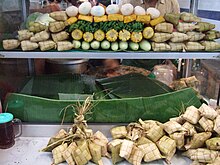
Gado-gado stall displaying the ingredients of the dish, including ketupat
Recommended Bak kut Teh in Klang
Kedai Makanan Seng Huat: Bak Kut Teh (成发肉骨茶) @ Klang
Description
Klang is the popular destination
among diners in the Klang Valley when they fancy having Bak Kut Teh.
Among these popular Bak Kut Teh restaurants is one located under the
Klang bridge. One of the pioneer in selling bak kut teh in Malaysia.
Price
Pork Leg Bak Kut Teh (RM12 per person)
Food
The Bak Kut Teh with Sai Kuat and Pai Kuat, Yau Char Kuay, Loh Tan (Stewed egg), and Tau Foo Pok, Original Bak Kut Teh, Yau Mak
Wantan Mee
This is not the best Wantan Mee in Penang but it is good. Nameless and often referred as the ‘Wantan Mee in front of furniture shop at Chulia Street‘,
the noodles here tastes slightly different from those in Klang Valley.
The noodles are more more springy, tossed with light soy sauce hence the
fairer appearance and has a stronger lard presence. Even the wantan
dumplings look different too, they are so tightly wrapped.

There are alot of stall selling this food. However it is very subjective that which one is more delicious.

There are alot of stall selling this food. However it is very subjective that which one is more delicious.
Roti canai
The roti canai dish
Composition
The dish is composed of dough containing copious amounts of fat, egg, flour and water (although eggless vegan versions do exist). The form of fat used is usually ghee (clarified butter). Some people add sweetened condensed milk to the mix. The entire mixture is kneaded thoroughly, flattened, oiled and folded repeatedly. It is then allowed to proof and rise, and the process is repeated. The final round of preparation consists of flattening the dough ball, coating it with oil and then cooking on a flat iron skillet with a lot of oil. The ideal roti is flat, fluffy on the inside but crispy and flaky on the outside.In Malaysia, roti canai is famous and well organised by indian people.
satay
Satay , is a dish of marinated, skewered and grilled meat, served with a sauce.Satay may consist of diced or sliced chicken, goat, mutton, beef, pork, fish, other meats; the more authentic version uses skewers from the midrib of the coconut palm frond, although bamboo skewers are often used. These are grilled or barbecued over a wood or charcoal fire, then served with various spicy seasonings.
Satay originated in Java, Indonesia. Satay is available almost anywhere in Indonesia, where it has become a national dish. It is also popular in many other Southeast Asian countries, such as: Malaysia, Singapore, Brunei, Thailand as well as in the Netherlands, as Indonesia is a former Dutch colony.
Satay is a very popular delicacy in Indonesia; Indonesia's diverse ethnic groups' culinary arts (see Indonesian cuisine) have produced a wide variety of satays. In Indonesia, satay can be obtained from a travelling satay vendor, from a street-side tent-restaurant, in an upper-class restaurant, or during traditional celebration feasts. In Malaysia, satay is a popular dish—especially during celebrations—and can be found throughout the country.
Satay Receipe!
Chinese dumpling
Chinese cuisine (Dumpling)

A plate of guotie.

A dumpling filling consisting of minced chicken and spring onion.
If dumplings are laid flatly on a pan, first steamed with a lid on and with a thin layer of water, then fried in oil after the water has been evaporated, they are called guotie or as the Maillard reaction occurring on the bottom of the dumpling make the skin crispy and brown. The same dumplings are called jiaozi if they are plainly steamed.
The wonton ) is another kind of dumpling. It is typically boiled in a light broth or soup and made with a meatier filling. The skin wrapping for wontons is different—thinner and less elastic—than that used for jiaozi[citation needed]. Wontons are more popular in Southern China (Shanghai, Guangdong, Hong Kong etc.) whereas in Northern China, jiaozi are more popular. Jiaozi, wonton and potstickers are all wrapped differently.
Another type of Chinese dumpling is made with glutinous rice. Usually, the glutinous rice dumplings 粽子 zongzi are triangle or cone shaped, can be filled with red bean paste, Chinese dates or cured meat depending on region. Glutinous rice dumplings are traditionally eaten during the Duanwu Festival.
Chinese cuisine includes sweet dumplings. Tangyuan are smaller dumplings made with glutinous rice flour and filled with sweet sesame, peanut, red bean paste. Tangyuan may also be served without a filling. Tangyuan are eaten on the 15th day of Chinese New Year, or the Lantern Festival. There are also other kinds of dumplings such as har kao, siew mai, small cage-steamed bun (xiaolongbao), pork bun and crystal dumpling.
See also: dim sum 点心 for descriptions of several other kinds of dumplings such as gau and taro root dumplings.
Nasi Lemak
Nasi lemak is a fragrant rice dish cooked in coconut milk and "pandan" leaf commonly found in Malaysia, Brunei, Singapore, Riau Islands and Southern Thailand. Malaysia proclaims it its national dish and a national heritage of Malaysia, although it's widely served in other parts of the region. It is not to be confused with Nasi Dagang sold on the east coast of Malaysia or Terengganu and Kelantan
although both dishes can usually be found sold side by side for
breakfast. However, because of the nasi lemak's versatility in being
able to be served in a variety of manners, it is now served and eaten
any time of the day.
With roots in Malay culture and Malay cuisine, its name in Malay
literally means "fatty rice", but is taken in this context to mean
"rich" or "creamy". The name is derived from the cooking process whereby
rice is soaked in coconut cream and then the mixture steamed. This is the same process used to make a dish from their neighboring country, Indonesia, which is nasi uduk, therefore the two dishes are quite similar. Sometimes knotted screwpine leaves are thrown into the rice while steaming to give it more fragrance. Spices such as ginger and occasionally herbs like lemon grass may be added for additional fragrance.
Traditionally, this comes as a platter of food wrapped in banana leaves, with cucumber slices, small fried anchovies (ikan bilis), roasted peanuts, hard boiled egg, and hot spicy sauce (sambal) at its core. As a more substantial meal, nasi lemak can also come with a variety of other accompaniments such as ayam goreng (fried chicken), sambal sotong (cuttlefish in chilli), cockles, stir fried water convolvulus (, pickled vegetables , beef (beef stewed in coconut milk and spices) or paru (beef lungs). Traditionally most of these accompaniments are spicy in nature.
Nasi lemak is widely eaten in Malaysia and Singapore, even as a dish
served in Malaysian schools. Commonly a breakfast dish in both
countries, it is normally sold at hawker food centres in Singapore and
roadside stalls in Malaysia. It often comes wrapped in banana leaves,
newspaper or brown paper,and it could be served on a plate. However,
there are restaurants which serve it as a noon or evening meals, making
it possible for the dish to be eaten all day. Nasi lemak kukus which means "steamed nasi lemak" is another name given to nasi lemak served with steamed rice.
Wednesday, May 16, 2012
Laksa
Laksa is a popular spicy noodle soup from the Peranakan culture, which is a merger of Chinese and Malay elements found in Malaysia and Singapore, and to a lesser extent, Indonesia.
There are two basic types of laksa: curry laksa and asam laksa. Curry laksa is a coconut curry soup with noodles, while asam laksa is a sour fish soup with noodles. Thick rice noodles also known as laksa noodles are most commonly used, although thin rice vermicelli (bee hoon or mee hoon) are also common and some variants use other types
Curry laksa
Curry laksa (in many places referred to simply as “laksa”) is a
coconut-based curry soup. The main ingredients for most versions of
curry laksa include bean curd puffs, fish sticks, shrimp and cockles. Some vendors may sell chicken laksa. Laksa is commonly served with a spoonful of sambal chilli paste and garnished with Vietnamese coriander, or laksa leaf, which is known in Malay as daun kesum.
This is usually known as Curry Mee in Penang rather than curry laksa, due to the different kind of noodles used (yellow mee or bee hoon, as opposed to the thick white laksa noodles). Curry Mee in Penang uses congealed pork blood, a delicacy to the Malaysian Chinese community. Two of the well known places to try curry mee is at Lorong Seratus Tahun and Chulia Street.[citation needed]
The term "Curry laksa" is more commonly used in Kuala Lumpur or Singapore. Laksa is popular in Singapore and Malaysia, as are laksa yong tau foo, lobster laksa, and even plain laksa, with just noodles and gravy.
Variants of curry laksa include:
- Laksa lemak, also known as nyonya laksa (Malay: Laksa nyonya), is a type of laksa with a rich coconut gravy. Lemak is a culinary description in the Malay language which specifically refers to the presence of coconut milk which adds a distinctive richness to a dish. As the name implies, it is made with a rich, slightly sweet and strongly spiced coconut gravy. Laksa lemak is usually made with a fish-based gravy (with vegetarian food stalls omitting fish) and is heavily influenced by Thai laksa (Malay: Laksa Thai), perhaps to the point that one could say they are one and the same.
- Laksam, a speciality of the Northeastern Malaysian states of Kelantan, Terengganu and Kedah, is made with very thick flat white rice flour noodles in a rich, full-bodied white gravy of boiled fish and coconut milk. Though usually made of fish flesh, it is sometimes made with eels. Traditionally laksam is eaten with hands rather than with eating utensils due to the gravy's thick consistency
- Katong laksa (Malay: Laksa Katong) is a variant of laksa lemak from the Katong area of Singapore.
In Katong laksa, the noodles are normally cut up into smaller pieces so
that the entire dish can be eaten with a spoon alone (that is, without
chopsticks or a fork). Katong laksa is a strong contender for the
heavily competed title of Singapore's national dish.
Asam laksa
Asam laksa is a sour, fish-based soup. It is listed at number 7 on World's 50 most delicious foods complied by CNN Go in 2011.Asam (or asam jawa) is the Malay word for tamarind, which is commonly used to give the stock its sour flavor. It is also common to use asam keping (also known as asam gelugor), dried slices of sour mangosteen, for added sourness. The modern Malay spelling is asam, though the spelling assam is still frequently used.The main ingredients for asam laksa include shredded fish, normally kembung fish or mackerel, and finely sliced vegetables including cucumber, onions, red chillies, pineapple, lettuce, common mint, "daun kesum" (Vietnamese mint or laksa mint) and pink bunga kantan (ginger buds). Asam laksa is normally served with either thick rice noodles or thin rice noodles. And topped off with "petis udang" or "hae ko" , a thick sweet prawn.
Variants of asam laksa include:
- Penang laksa (Malay: Laksa Pulau Pinang), also known as asam laksa from the Malay for tamarind, comes from the Malaysian island of Penang. It is made with mackerel (ikan kembung) soup and its main distinguishing feature is the asam or tamarind which gives the soup a sour taste. The fish is poached and then flaked. Other ingredients that give Penang laksa its distinctive flavour include lemongrass, galangal (lengkuas) and chilli. Typical garnishes include mint, pineapple slices, thinly sliced onion, hε-ko, a thick sweet prawn paste and use of torch ginger flower. This, and not 'curry mee' is the usual 'laksa' one gets in Penang.
- Perlis laksa (Malay: Laksa Perlis) is similar to Penang Laksa but differs in garnishing used such as catfish and eel fish. The famous Perlis laksa can be found in Kuala Perlis.
- Kedah laksa (Malay: Laksa Kedah) is very similar to Penang laksa and only differs in the garnishing used. Sliced boiled eggs are usually added to the dish. Kedah laksa used rice to make a laksa noodle. The famous laksa in Kedah is Laksa Telok Kechai.
- Ipoh laksa (Malay: Laksa Ipoh), from the Malaysian city of Ipoh, is similar to Penang laksa but has a more sour (rather than sweet) taste, and contains prawn paste.
- Kuala Kangsar Laksa (Malay: Laksa Kuala Kangsar), made of wheat flour (usually hand made). The soup is rather lighter than the common laksa taste and so much different from Ipoh Laksa in shape, taste and smell. The local municipal council even built a complex called "Kompleks Cendol dan Laksa" near the river bank of the Perak River. It is the main attraction for tourists in Kuala Kangsar
Here is the receipe to prepare laksa
Food Screening
Today, I would like to share this video in the very beginning with you all. This is because this video generally explain most of the famous food in Malaysia and is in the top list of the food that must try when you in Malaysia.
Enjoy!
What do you feel after viewing this video clip? Feel hungry? Delicous?
If yes, do visit and stay tune with my introduction on more food and some receipe that allowed you to even cook yourself at home.
Enjoy!
What do you feel after viewing this video clip? Feel hungry? Delicous?
If yes, do visit and stay tune with my introduction on more food and some receipe that allowed you to even cook yourself at home.
The Introduction
Malaysia is a awesome place in which there are different races living together. This gather the traditional cuisine from Chinese, Malay and Indian. Generally, the food shows and represent the background of one culture and the taste of their life respectively.
Especially, Penang, which is a food paradise in Malaysia as well as is well known thoughtout the world. Tourist normally visit Malaysia for food besides for historical tourismn.
Annually, Malaysia will conduct a Food Carnival gathering all sorts of food throughout the states and this gives chance to everyone to try out food.
Especially, Penang, which is a food paradise in Malaysia as well as is well known thoughtout the world. Tourist normally visit Malaysia for food besides for historical tourismn.
Annually, Malaysia will conduct a Food Carnival gathering all sorts of food throughout the states and this gives chance to everyone to try out food.
Thursday, May 3, 2012
Subscribe to:
Posts (Atom)

